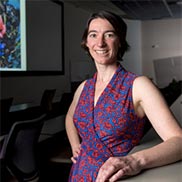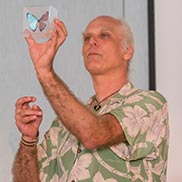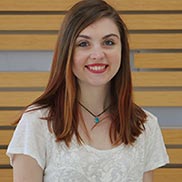
In the College of Sciences at Georgia Tech, 2020 started out as ordinarily as most other spring semesters on campus. Students, faculty and staff filled lecture halls, offices, and labs. They began settling into research, projects, and studying for exams — with many looking forward to spring break travels, commencement festivities, and celebrating the end of another academic year on campus alongside colleagues, classmates, mentors, and friends.
Researching a curious coronavirus
Yet, as spring semester quietly began to pick up speed, so did something else: the international incidence of a novel coronavirus. Spotlighted in an open forum held on February 10 by the Center for Microbial Dynamics and Infection, the outsized “size, speed, and strength” of this new virus was the subject of three talks and a discussion led by a pair of Georgia Tech scientists and their colleague in Washington State.
Joshua Weitz, a professor in the School of Biological Sciences and Director of the Interdisciplinary Ph.D. in Quantitative Biosciences, shared insights on coronavirus outbreak strength estimation. Phillip Santangelo, a professor in the Coulter Department of Biomedical Engineering, discussed opportunities for drug development. And Trevor Bedford, a faculty member in the Vaccine and Infectious Disease division of the Fred Hutchinson Cancer Research Center in Seattle, joined via BlueJeans video conference service to present his work on real-time sequence analysis and “nCOV” phylodynamics.
Across campus and around the world, researchers were already working together to better understand the evolution, epidemiology, effects, challenges, potential futures and possible solutions for a virus that would receive its official name the day after the campus coronavirus forum was held: severe acute respiratory syndrome coronavirus 2 (SARS-CoV-2).
A month later, sweeping spread of COVID-19, the disease caused by SARS-CoV-2, would swiftly upend schedules across campus, alongside classrooms and labs around the country — mirroring efforts underway around the globe to rapidly respond to a newly classified pandemic.
And as COVID-19 began to enter the American lexicon and universities were faced with “a worldwide challenge unlike any in living memory,” the greater Georgia Tech community had joined the fight, contributing expertise, innovation, and indomitable spirit to the effort.

Rapid response and a revamp to remote
On March 16, the University System of Georgia announced that all courses across the state’s 26 institutions would move to online instruction for the remainder of spring semester, a decision soon followed by another to conduct May and summer courses in distance format. With word that classes would resume online after an extended spring break, College of Sciences faculty, teaching assistants, and staff set to work on adjusting and revamping classes for remote learning environments.
Most professors were already familiar with Canvas, Georgia Tech’s online course management system. But a smaller number had used Canvas’ chat and quizzing functions, or BlueJeans software to stream, record and post videos of their classes. In tandem with colleagues across campus, the College’s Academic and Research Computing Services IT support group designed and held a series of online tutorials and training sessions, led by Lew Lefton and Justin Filoseta, to help rapidly equip instructors and staff with a complete toolbox of remote teaching resources.
“College of Sciences faculty, teaching assistants and students rose to the significant challenges associated with retooling the entire teaching and learning process in the middle of spring semester,” says David Collard, Associate Dean for Academic Programs, and a professor in the School of Chemistry and Biochemistry. “In this process, many faculty will likely have been introduced to new online instructional tools that they may choose to use even when we are back to teaching on campus.”
Two months together—apart
Now, after research ramp downs and campus shut downs, with safe return and recovery planning underway, and spring semester and graduation in our rear view—two months after we officially began the transition to Georgia Tech’s first semester of remote teaching, learning, and conducting critical business and research from a distance—we’re gearing up for another unprecedented moment: a second semester of remote learning for May and summer terms.
We wanted to take a moment to talk to people in the College of Sciences, to check in about the past couple of months, talk about distance learning and teaching experiences, and to ask and share answers to one really important question: So, how’s it all going?
What follows is a collection of thoughts from our undergraduates, graduate teaching assistants, and faculty, gathered over the phone and by email over the first two weeks of May 2020 by Renay San Miguel, communications officer and science writer for the College of Sciences at Georgia Tech.
How have you adapted to remote learning as an instructor or student?
 Mary Holder
Mary Holder
Academic Professional and Advisor in Neuroscience in the School of Psychology
During the week of spring break, I led in the creation of a Canvas course for all neuroscience majors as a way to share information, forms, procedures, etc. This also provided the opportunity to answer student questions in a way to benefit all the students. We also reached out to our students in ‘ready to learn’ surveys that included questions about their personal situations after the move to online; several of the students noted in that survey particular issues, and I made it a point to reach out to those students individually to see how I could help.
I routinely start my advising sessions by asking how my students are doing, but after the switch to online, I asked more specific questions about their adjustments: Do they have quiet study/work space? Are they experiencing stressors that are disrupting their ability to study and learn? How are they supporting their mental and emotional health? While most of the students indicated that they were in safe and supportive learning environments, a few indicated they were struggling with structuring their time or maintaining motivation. Those students and I discussed particular strategies that may be useful, and I reminded them of all the Georgia Tech resources that they could access even in this distance format.
 Sara Singer
Sara Singer
Third Year Undergraduate in the School of Biological Sciences
I found myself getting depressed and wanting to sit around all day because I felt a little hopeless. This is when I realized that I needed to start exercising more and finding some hobbies to help me recover such as gardening, cooking, blogging, etc. I made sure to interact with my family a lot, and I have especially been leaning on my siblings for that emotional and social support. While my family has been a huge help, my friends are also so important to me and I feel very distant from them during this time. I think it really helped me to find a quarantine buddy outside of my family to visit with because it allowed me to get the support I need with a face-to-face interaction.
 Chrissy Spencer
Chrissy Spencer
Senior Academic Professional in the School of Biological Sciences
To make things more interactive, I was told to get some of that creative thinking from the students, and some came from me. I asked all sorts of questions from them, including, how do you want to see the syllabus modified for these kinds of assignments? We always did a lot of in-class exercises, questions around math equations or images or creating graphs, where they had to do some in-depth analysis, and we always did them in teams. I didn’t want to lose that and they didn’t either, but we had to figure out how to do that.
In-class exercises were on a worksheet as a list of questions online. I set that up ahead of time and made enough copies so that every team had enough. I put the students in breakout rooms and each room had their own doc. They could all edit at the same time in each breakout room. And I could see into their breakout rooms on the tech platform. If they got one part right but got another wrong, I was able to comment in the doc and say, “go back and work on it again.” They were able to respond very quickly.
 Benjamin Breer
Benjamin Breer
Second Year Undergraduate in the School of Physics and School of Aerospace Engineering (Dual Major)
My solution? Create my own structure. I set a standard 8:00 AM to 5:00 PM work schedule, with a lunch break in between. As my father will attest, the morning ‘commute’ from my bedroom to the ‘office’ occasionally resulted in a delayed start. We went for walks in our neighborhood every afternoon at 5:00 PM and made dinner shortly thereafter. Once a week, we had a video call with family living in other states.
This routine established a sense of structure that enabled me to continue focusing on my work while also being able to stay connected to family and friends. From bi-weekly Skype calls to catching up individually over the phone, my friends and I discussed this new world we live in. We shared several opinions regarding the online learning experience, including the flexibility of many professors and accommodating measures being taken, such as moving to asynchronous lectures to account for students living in different time zones. We agreed that many courses seamlessly transitioned to a complete online format.
Were there any pleasant surprises from remote learning? Any creative workarounds to the new situation?
 Declan McCarthy
Declan McCarthy
Graduate Teaching Assistant in the School of Chemistry and Biochemistry
I’m grateful for the fact that most faculty have been extremely understanding and willing to work with students, including graduate students, regarding any of the potential issues that may have arisen as a result of COVID-19. Another sort of anecdotal experience I would like to share is regarding some of the virtual meetings we have participated in as graduate students. In spite of being physically distant from others, I feel as though I may have gotten to know a different side of my peers. In some of the meetings we have all checked in with each other and are seeing some personal aspects of each other’s lives, like seeing someone’s dog or hearing a child ask about snack time.
 Marc Weissburg
Marc Weissburg
Professor in the School of Biological Sciences
I think the fact that the students understood clearly that their learning was really contingent on being able to interact with each other, and finding ways to do that outside the technology, was a nice surprise. Not every student did that, but a number of students did. That indicates to me that they were still trying to be motivated, but also at least as a result of their prior experience in class, actually talking to their classmates, they understood how valuable that was to them, and made some attempt to get that experience in whatever way they possibly could. That’s something that would always come up in course reviews, where students ended up appreciating that it was good to see they were realizing that in the moment, and they felt they needed to get that done in some other way.
I think the other nice surprise is that the students used this as an opportunity to talk about other stuff that they might not have talked about. Because it could be difficult to focus on what you’re learning, the students’ attention could wander a little bit. I remember the first week we came back doing this, I was in my home office, and I asked the students if they had any questions. One of the students said, “yeah, what’s the painting you have on your wall? It looks interesting.” We got into this discussion on what this art was about, and how I came to have it, and why art is interesting and important. It was nice to be able to have some of those normal interactions working remotely.
 Sydney Popsuj
Sydney Popsuj
Graduate Teaching Assistant in the School of Biological Sciences
I thought switching to remote learning would create really overwhelming and difficult testing procedures for students. This concern was also shared by the course instructors and students because it's very hard to create a fair environment for everyone while also ensuring academic integrity. After a lot of discussions with both the professors and the students, we were eventually able to devise a way of testing that took into account the myriad new variables remote learning introduced. For all of the original anxiety, we found the class averages substantially increased as did students' confidence in the materials.
 Bruce Walker
Bruce Walker
Professor in the School of Psychology and School of Interactive Computing
Walker and School of Interactive Computing graduate student Brianna Tomlinson recently collaborated with the University of Colorado-Boulder to develop a new course, Sound and Sonification Design for Interactive Learning Tools, for the education technology platform Coursera.
Our interest is more about how online learning is new to many of us, and we all want to make the experiences for students as engaging and as inclusive as possible. Adding sound to our online learning materials, be it on a learning platform, or just web pages and demos and simulations, can help with both of these goals.
But it is not always clear how to start when it comes to designing sounds that would be added to our teaching materials. The Sonification Lab is well known for our research in multimodal and auditory learning tools, so we wanted to bring our expertise in this area out to the masses. We developed an online course that will help teachers, educational materials developers, sound designers, and others make sounds that are effective and engaging.
The Coursera platform provided us with a great way to bring that content to our potential audience. Since both Georgia Tech and the University of Colorado-Boulder are affiliated with Coursera, it was relatively straightforward to jointly develop the course, have input from both universities, and then release the course under both schools' catalogs. Anyone who is interested in the topic can take the course for free, and then hopefully use what they learn to make their online and interactive learning content more accessible and more effective.
What has been the biggest challenge for you after the switch to remote learning?
Sara Singer
For me, the biggest challenge to switching online was staring at electronics all day. I used to enjoy getting to walk around campus in between classes to get some fresh air, but it’s hard to have that same feeling when I am stuck on my computer all day for classes, homework, meetings, office, hours, exams, and anything else. Staring at a screen for eight hours a day is not healthy for anyone, yet professors and students are both having to do this in order to make virtual classes work. I find that it’s hard for me to dedicate the same amount of time and energy to my work while living at home and also trying to take care of my mental and physical health. I used to be able to stay focused on my work throughout the day because I was also getting social interactions and intermediate breaks. However, it’s hard to find those same outlets while staying at home and avoiding human interaction.
 Dan Margalit
Dan Margalit
Professor in the School of Mathematics
The most important differences and difficulties were keeping a personal connection with the students, managing student anxiety, and designing assessments. The personal connection was difficult for several reasons. For one thing, I could not figure out how to get the technology platform to show me more than four students' faces at a time. It is always really helpful to see confused looks or nodding heads while teaching. Since I didn't really have that, I had to ask the students to do things like input their affirmations in the chat if they were understanding (virtual head nodding). To try to build connection, I came early to class to chat a little with the students. I even played music at the start and end of class to keep things engaging.
Benjamin Breer
I am a big believer in what I call ‘knowledge osmosis’. Even if you are tired and struggling to pay attention, there is no substitute for in-person instruction. Just sitting in the classroom facilitates some learning, whether we are aware of it or not. I think the biggest challenge for me when switching to a completely remote learning experience was the sudden removal of the in-person classroom experience and any sense of structure: activities like research, clubs, and spending time with friends constituted the scaffolding that held my college life together.
Marc Weissburg
What’s important in my class is that the students are actually working together, talking about it, discussing, putting ideas down on paper. That is the most challenging part of this way of learning. When we migrated to a distance format, keeping the students engaged, keeping them motivated, keeping them asking questions of themselves and of us (instructors), and not being passive was the biggest challenge. ... In class I would walk around, along with teaching assistants, and we would say, “show me what you’re doing”. None of that could happen in the format available. One of the most unpleasant surprises for me is how sterile it is to be talking to the students through a computer, where I can’t really read their body language in a way that I can when I’m in class with them. It’s really stressful, and why after a day of Zoom meetings you’re tired, you’re spending so much mental energy trying to pick up on social cues that you innately get when you’re in somebody’s presence, and now you’re trying to compensate for them.
Sydney Popsuj
As someone who wants to become a professor of biology one day, I really struggled with not getting to engage with my students as easily. The best part of being a TA for me is getting to watch my students grow, and discovering what makes them passionate about biology. I no longer had the opportunity for students to drop by after class or recitation to tell me about how this lesson made them realize a new field they wanted to explore, or how something I taught them in recitation ended up being a question their trivia team encountered. It was rather disheartening to feel disconnected from their individual learning paths, but eventually we all adjusted.
What has been your experience with remote learning technology?
 Nicole “Nikki” Aiosa
Nicole “Nikki” Aiosa
Graduate Teaching Assistant in the School of Chemistry and Biochemistry
I am a first-year GTA, and everything has been an adjustment this past year, so being flexible wasn't really new to me. It is definitely more challenging to keep the attention of my students online, but I understand it is a difficult transition for them as well. In my undergraduate studies, I took several fully online courses and some hybrid online courses where lectures were online, but you came into a lecture hall to take a proctored exam.
Chrissy Spencer
In my course, everything went fine. The upper level courses are heavily discussion-based, and everyone was able to be on video and audio, and make it work. I checked in with the students incessantly to make sure they were okay, to make sure they could come to class and give them options if they couldn’t. The expectation was you had to be there to have face-to-face discussions with peers, but I wanted a backup plan, and several students took me up on alternative assignments. I recorded everything and posted on a Canvas site. We had access to all course material, and they did fine.
 Stephanie Bilodeau
Stephanie Bilodeau
Graduate Teaching Assistant in the School of Biological Sciences
Teaching online was easy in terms of technology, but challenging in terms of content for the ecology lab I was TAing. We just made all the labs and projects for the rest of the semester independent for students to work on in their own time, and then turned our scheduled lab periods into ‘open office hours’-like consulting sessions on BlueJeans, where students could ask questions of the TA or other students and get help on these independent assignments — sort of an extreme ‘flipped classroom’ approach. Having said that, ecology lab is meant to be a practical, interactive course, and transitioning it online this way really took away from what the students were able to learn and experience.
As a student, organic interactions with other students and with the professor have been the biggest thing lost with remote instruction. Even if all students keep video on, which our software and other platforms typically do not handle well, it is difficult to ask and answer questions, especially in large classes. I do think WebEx, which the class I teach now is using, works a bit better for this. It is also very frustrating that other students don’t always understand appropriate protocol when on a big group call, and will forget to mute their mics when not speaking, even when explicitly asked to. Some platforms allow instructors to mute everyone automatically, but not all instructors remember to do this.
Marc Weissburg
Theoretically, technology should come to the rescue, but in practicality, no. Some of this is a fundamental limitation, and some of it is some sort of software glitchiness. Theoretically there’s a way to allow the software platform to set up sub chats within the platform, so that students can talk amongst themselves. The problem is as soon as you do that, I am excluded from the conversations, so I can’t actually do what I need to do, which is listen in on what the students are doing. It has some utility for the students to talk amongst themselves, but the software, at least for me and for other people, it’s so glitchy that this function does not work very well. I’ve tried it and sometimes it works and sometimes it doesn’t. Right now it’s unreliable enough so that trying to get that to work ends up being a distraction.
What’s the biggest lesson learned for you regarding remote learning? What advice would you give to faculty and students?
Stephanie Bilodeau
My advice to students is to take online courses seriously. Take some time before the first class and each day before the call starts to make sure your audio/video is set up, your notes or browser are accessible, and you have access to anything else you need, like Learning Catalytics or the course textbook or Canvas page. Also, show instructors the same respect you usually would and don’t email them with questions an hour before an assignment is due. Just because we are all working from home does not mean that instructors do not still have other responsibilities. In fact, they may have more.
As an instructor, take time before classes start to test out whatever platform(s) you intend to use with TAs and/or volunteer students in the class. Holding one or more voluntary ‘practice sessions’ can help. The professors I know who did this had a much smoother transition back into actual classes when Georgia Tech went fully remote. This also gives students who may be worried about their setup an opportunity to jump on with the instructor or TA and a small number of peers, and make sure things work in a less stressful environment without disrupting class itself.
Marc Weissburg
There’s the opinion that remote delivery is a magic bullet that will make education easier and less costly, and more widely available to people, and that it will democratize education. Nothing is further from the truth. The way we do it now, online learning will disadvantage people because of the technology limitations, and it’s only suitable for a very small portion of students who have the right mental habits to be able to deal with it. It undervalues what teachers do, and gives people the false idea that content and learning are the same thing.
Nicole “Nikki” Aiosa
We need to make these online courses much more interactive, even more so than in person. This will hopefully keep everyone more engaged.
Dan Margalit
Overall, the class went well from a technical perspective, all things considered. So I know we can do this as long as we need to. But I don't think we should start closing down the campus in favor of online learning. I certainly missed running into my students around campus, and I know the students missed seeing each other. I do think it is a good time to reflect on what we like about being on campus, so we can be ready to do those things even better when we get back. I also think it's a good time to think about what is better about online learning, so we can continue to do those, as well!
The Center for 21st Century Universities at Georgia Tech
The Center for 21st Century Universities at Georgia Tech (C21U) is also gathering data from faculty and surveys on how the sudden switch to remote learning has impacted and evolved instruction. The goal is to find out what technologies and methods worked well, and to understand challenges and opportunities for future learning. Learn more here.
Related Links
- Georgia Tech: Helping Stories
- Georgia Tech: Monitoring Coronavirus
- Georgia Tech Health & Well-Being
- Georgia Tech Archives: Keep Your COVID-19 Materials For Future Scholars
- Georgia Tech Science Forum Spotlights Coronavirus Outbreak
- Coursera: Sound and Sonification Design for Interactive Learning Tools
- Holder, Weitz, Nie Recognized by Georgia Tech for Teaching, Research, Mentorship Activities
- Five Sciences Faculty Honored with Georgia Tech Center for Teaching and Learning Awards
- Petit Undergraduate Research Scholars “Adapting to the New Normal”
- Immunity of Recovered COVID-19 Patients Could Cut Risk of Expanding Economic Activity
- Keeping Connected with Science: The Stay at Home Journal Club
- Meet the Marine Biologist Helping Create COVID-19 Test Kits
- Tips for Organizing Online Conferences, from Biogeochemistry
- Nonlinear Science Seminar: Dynamics of COVID-19: Near- and Long-Term Challenges
- Chemistry and Biochemistry Present: COVID-19 Research and Response Efforts
- Will Smartphones Help Us Keep COVID-19 Under Control?
- Georgia Tech Produces Key Components for Governor’s Coronavirus Test Initiative
- A Faculty Message For You: #SwarmStrenGTh
- College of Sciences Celebrates 2020 Graduates


